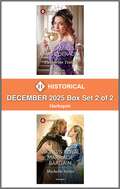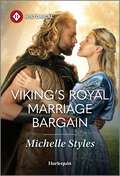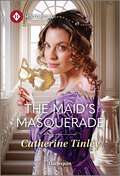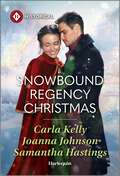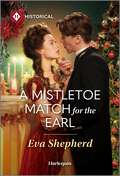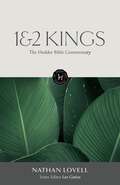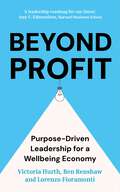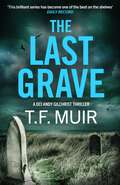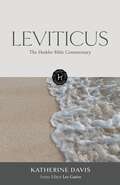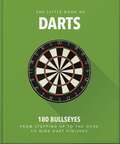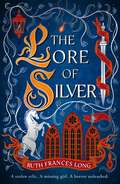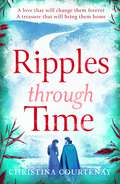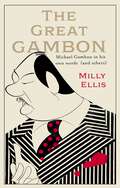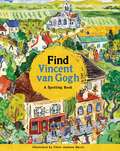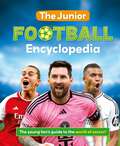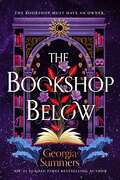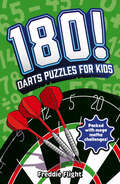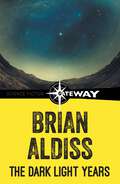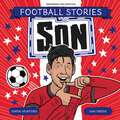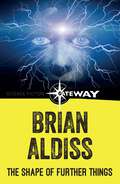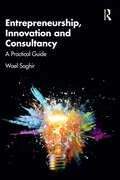- Table View
- List View
Harlequin Historical - December 2025 - Box Set 2 of 2
by Michelle Styles Catherine TinleyHarlequin Historical – December 2025 – Box Set 2 of 2Harlequin ® Historical brings you a captivating duo of thrilling new romances in one collection!This boxset includes:THE MAID&’S MASQUERADEPart of The Heiress SwitchBy Catherine Tinley(Regency)On a transatlantic voyage, English maid Marguerite hatches a plan with an American heiress to temporarily trade places when they arrive in England. Forced into servitude, this is Marguerite&’s chance to re-enter Society, and posing as the betrothed of Benedict, Earl of Linford—the man at fault for her circumstances—is the perfect opportunity for revenge! But her anger is soon replaced by an unsettling attraction. Still, Benedict caused her to lose everything once, so she won&’t lose her heart to him now—even when he reveals some unexpected truths… VIKING&’S ROYAL MARRIAGE BARGAINBy Michelle Styles(Viking)Viking Rand is resolute. He will secure a marriage alliance with the kingdom of Islay. But whilst battle-hardened Rand is prepared for enemy attack, he&’s wholly unprepared for the proposal to come from Princess Svanna…his first love, before war ripped their lives apart. A union with Rand is the last thing that Svanna&’s hateful stepfather will allow. Not least because she&’s been forced to harbour a royal secret that could throw Islay into chaos. Rand&’s kiss is still etched into Svanna&’s memory, but can she trust the fierce warrior before her?
Viking's Royal Marriage Bargain
by Michelle StylesA second chance, marriage of convenience Viking romance The maiden he never forgot Becomes the bride he never expected! Viking Rand is resolute. He will secure a marriage alliance with the kingdom of Islay. But whilst battle-hardened Rand is prepared for enemy attack, he&’s wholly unprepared for the proposal to come from Princess Svanna…his first love, before war ripped their lives apart. A union with Rand could bring peace to their kingdoms, but it's the last thing that Svanna&’s hateful stepfather will allow. Not least because she&’s been forced to harbour a royal secret that could throw Islay into chaos. Rand&’s kiss is still etched into Svanna&’s memory, but can she trust the fierce warrior before her? From Harlequin Historical: Your romantic escape to the past.
The Duke's Christmas Fake Fiancée
by Sophia WilliamsA festive friends-to-lovers Regency romance Their engagement ruse …wasn&’t supposed to include desire! Lady Cecily Carlow knows she will never marry. No matter—the money she will earn from her first novel should allow her to live independently. But when her odious aunt finds Cecily a rude but willing fiancé, she needs a plan—fast! Felix, Duke of Garth, has a way to help his best friend: a fake engagement for the festive season! Felix will never love again after losing his wife, but making Cecily his temporary fiancée will see off her suitor. Yet, as Christmas draws near, the unexpected attraction between them grows shockingly hard to resist!From Harlequin Historical: Your romantic escape to the past.
The Maid's Masquerade (The Heiress Switch)
by Catherine TinleyAdventure awaits when an heiress and a maid swap places in a brand-new duet, The Heiress Switch, from award-winning author Catherine Tinley Undercover as the Earl&’s fiancée… Looking to settle old scores On a transatlantic voyage, English maid Marguerite hatches a plan with an American heiress to temporarily trade places when they arrive in England. Since being forced into servitude, this is Marguerite&’s chance to re-enter Society, and posing as the betrothed of Benedict, Earl of Linford—the man at fault for her circumstances—is the perfect opportunity for revenge! But her anger is soon replaced by an unsettling attraction. Still, Benedict caused her to lose everything once, so she won&’t lose her heart to him now—even when he reveals some unexpected truths…From Harlequin Historical: Your romantic escape to the past.The Heiress SwitchBook 1: The Maid's MasqueradeBook 2: The Undercover Heiress
Snowbound Regency Christmas
by Carla Kelly Joanna Johnson Samantha HastingsThree heart-warming forced proximity romance novellas to cosy up with this festive season Three snow-kissed Regency romances In one festive volume! In A Christmas Houseguest by Carla Kelly, when a snowstorm stops their mailcoach, Rosie offers a fellow passenger sanctuary at her farm. War-weary from the navy, Andy will find his Christmas angel hard to leave…In Their Yuletide Reunion by Joanna Johnson, rejecting Lieutenant Fitzjames&’s proposal is Jane&’s greatest regret. Now, her future is in peril. Until an unexpected Christmas invitation leads to a second chance!In The Christmas Husband Charade by Samantha Hastings, Devin finds himself snowed in with Julia—the woman who jilted his brother! When he is forced to masquerade as her husband, their mutual hatred evolves into an irresistible connection…From Harlequin Historical: Your romantic escape to the past.
A Mistletoe Match for the Earl (Wayward Wallflowers)
by Eva ShepherdThe start of a lively new spicy Victorian trilogy, Wayward Wallflowers, from Eva Shepherd Snowed in With the new Earl… After a disastrous Season, Alice has given up on marriage for herself, but not for her friends. This Christmas, she&’ll matchmake her friend with a neighboring Earl. Only, when Alice calls upon him, she finds James a changed man—scarred, brooding, grumpy! And now she&’s snowed in with him… James Marlowe, the new Earl of Thornwood, has returned to take possession of his neglected Lake District estate and heal his broken heart. He has no need of Alice&’s irritating Christmas cheer. But when an awkward mistletoe kiss turns passionate, the ice begins to melt around his frostbitten soul…From Harlequin Historical: Your romantic escape to the past.Wayward WallflowersBook 1: A Mistletoe Match for the EarlBook 2: A Fake Betrothal for the Duke
The Hodder Bible Commentary: 1 & 2 Kings (Hodder Bible Commentary)
by Nathan Lovell'Praise be to the LORD who has given rest to his people Israel just as he promised. Not one word has failed on all the good promises he gave through his servant Moses.'1 KINGS 8:56The book of Kings is much more than an historical record. It is the story of the remarkable faithfulness of God to build the Kingdom he promised, even when his own people reject it. And it is about how different this Kingdom is to everything else the world has ever known.Nathan Lovell's thought-provoking commentary helps us to understand not only Israel's history, but how it shapes and challenges us today. As God works amongst his people, we begin to catch a glimpse of an entirely new type of world order. On the surface Kings is a book about power and glory, but by reading more deeply we begin to see the truth of Jesus' words, 'Blessed are the meek, for they will inherit the earth.'About the Hodder Bible CommentaryThe Hodder Bible Commentary is a comprehensive 50-volume Bible commentary series. Doctrinally sensitive and globally aware, its goal is to encourage a deepened knowledge and understanding of Scripture.Accessible and insightful expository commentary explores the timeless message of the Bible and applies it to the challenges of today's world. Written by a range of authors and supported by consultant editors from around the world, it represents a diversity of church and cultural contexts.With the full text of the NIV Bible interspersed with the commentary for easy reference, this series is ideal for preaching, teaching and personal study.
Beyond Profit: Purpose-Driven Leadership for a Wellbeing Economy
by Lorenzo Fioramonti Ben Renshaw Victoria HurthBeyond Profit brings together the latest academic research on Purpose-Driven Leadership and Organizations to show how leaders can create a Wellbeing Economy that is aligned with a sustainable future where we innovate and protect collective long-term wellbeing through governance that works. It is a must read for all leaders wanting to implement a coherent roadmap to meet the needs of the world we want - it will help you ask critical questions, learn from inspirational stories, and be armed with an innovative approach to find answers that will lead to a better tomorrow.Leaders make decisions with real consequences that are not just local but national and even global - they impact matters of intense importance; decisions with environmental, economic, societal and moral implications. The reality of leadership in times of uncertainty and risk places an unprecedented challenge at the door of today's generation of leaders. As a leader, you may often feel locked into pursuing sustained growth and endless increases in financial returns - while held back by less resources and more challenges around employees, customers, and new technologies.Perhaps you feel overwhelmed and weighed down by responsibility - troubled by the legacy you are leaving behind. It doesn't have to be this way.
The Last Grave: A pulse-pounding, gripping Scottish crime thriller (DCI Andy Gilchrist #14)
by T.F. Muir'All the makings of a classic series' - Mick Herron, author of the bestselling Slough House thrillers______________Glasgow, Scotland: When a man's body is pulled from the River Clyde, Strathclyde Police initiate a murder investigation that exposes deadly links to organised crime gangs. And when the matriarch of the notorious Shepherd family disappears, DCI Andy Gilchrist of St Andrews CID and his associate, DS Jessie Janes, are called upon to find her. But their investigation uncovers a historical trail of missing persons, now all presumed dead. Why pull in Gilchrist and Janes for a murder in Glasgow? Can they locate the missing bodies? As they dig deeper, they expose an illegal body disposal gang and a murderous plot to change the balance of criminal power in Scotland and beyond.But the organised crime gangs won't give up quietly, and they put in motion murderous acts of retribution, with their sights set firmly on Gilchrist. Leading the pack is Bully Reid, a career criminal and brutal killer who Gilchrist put away years ago, and who still pulls the strings from behind bars in Barlinnie prison.Can Gilchrist and Janes survive Bully's revenge? Or will they end up like all the others - just two more missing bodies? ______________ Readers and reviewers love the DCI Andy Gilchrist thrillers! 'DCI Andy Gilchrist is a real copper, flaws an' all... I read it one sitting' - Amazon reviewer ⭐⭐⭐⭐⭐ 'Thrilling... first page, a suspicious death, and we're off!' - Amazon reviewer ⭐⭐⭐⭐⭐ 'Fascinating storylines... police procedural at its best' - Amazon reviewer ⭐⭐⭐⭐⭐ 'Rebus did it for Edinburgh. Laidlaw did it for Glasgow. Gilchrist might just be the bloke to put St Andrews on the crime fiction map' - Daily Record 'Gripping and grisly, with plenty of twists and turns that race along with black humour' - Craig Robertson 'DCI Gilchrist gets under your skin. Though, determined, and a bit vulnerable, this character will stay with you long after the last page' - Anna Smith
The Hodder Bible Commentary: Leviticus (Hodder Bible Commentary)
by Katherine Davis50 volumes. 4 million words. Global representation.Engage with the latest theological thinking in this new, readable exposition of the Bible in 50 volumes. Covering all books of the Bible and including the full the Anglicised New International Version (NIV) text, the Hodder Bible Commentary series makes connecting scripture and scholarship easier than ever.Explore how the Bible intersects with 21st century life with commentary that is doctrinally sensitive and globally aware, sourced from a team of contributors representing a variety of cultural and ecclesiastical contexts from around the world.Designed to be accessible to all adult readers and particularly for those who preach, teach, and lead Bible studies, each book is split into manageable sections suitable for talks or study groups. Read the Bible text and the commentary side by side to gain a deep knowledge of scripture and the variety of interpretations that can be made from it.Be refreshed with new understanding. Be encouraged to apply your conclusions to life today.
The Little Book of Darts
by OHWith Luke "The Nuke" Littler's ascendance to the throne as the new King of Darts - at just 17 years old! - the medieval pub game of darts is experiencing a renaissance. The game's popularity is continuing to rise, with more and more countries stepping up to the oche and growing interest among the younger generations. In the past 12 months alone, the number of youngsters in Britain playing darts has doubled, with 35 per cent of the nation now more interested in the sport than they were two years ago.Of course, darts has always been popular, with legions of fans remaining loyal since its eighties heyday - who can forget Jim Bowen's Bullseye amassing more than 20 million weekly viewers when it was on TV? But now darts is in a new league all of its own, with people tuning into tournaments from across the globe.This little guide contains 180 fun and fascinating facts, quotes and stats about the new favourite sport, an intoxicating mix of precision throwing that suddenly turns into quick-fire maths. This tiny tome celebrates not only the game's latest rise to fame, but also its cherished 1,000-year history and the long list of players who have stood proudly at the oche, either down the pub or as professionals.With the World Darts Championship in December 2025 set to be the most viewed tournament ever, the world of darts is once again about to take flight. To quote the late, great Martin Fitzmaurice, "Are you ready? Ladies and Gentlemen... Let's... Play.... Darts!"Sample content:"I just wake up, play on my Xbox, have some food, have a chuck on the board, and go to bed... I don't engage with anything outside the house; I'm just level-headed."Luke Littler, after coming second in the World Darts Championship final, ESPN, January 2024."When I keep focus, when I keep believing in my own ability, anything is possible. I'm not here for the jolly, I'm here to win a tournament, and we all know that."Michael Van Gerwen, on his focus, Sky Sports, January 2025.Slop is the term given to a lucky or unintended score, often when a dart doesn't go where it was meant to, but still earns a decent score.
The Lore of Silver: The sequel to the thrilling magical heist fantasy, The Book of Gold, from the Feral Gods Trilogy. (The Feral Gods #2)
by Ruth Frances Long✨🗡️A STOLEN RELIC. A MISSING GIRL. A HORROR UNLEASHED.🗡️✨💫'History and enchantment woven in a seamless, intricate tapestry' Sarah Rees Brennan 💫💫 'Intricately plotted and vividly imagined' M.A. Kuzniar 💫Lyta is trying her best. She's determined to stay out of trouble, steer clear of her beloved Sylvian and the queen he is bound to serve, and-most importantly-not embarrass her brother Kit. So when Kit asks her to help the temple recover their stolen relics, Lyta can't say no. After all, who better to track down thieves than someone blessed by trickster god Ennin himself?But the search quickly leads her into conflict with the Blacksmiths' Guild-and when Sylvian steps in to protect her, staying away from palace politics becomes harder than Lyta ever imagined.Kit misses Ben. The scholar has been buried in a secretive project at the Blacksmiths' Guild, and their time together has dwindled to fleeting moments. But when a desperate search for Lord Alderton's missing sister pulls Kit deeper into that same shadowy world, he uncovers a conspiracy reaching far beyond one lost girl.Because when Lyta crossed the veil, she tore a hole in it. And now something vast and ancient is clawing its way into Amberes. Something so terrible, even the gods are afraid.Tropes included:Magical Heist 💫Childhood friends to enemies...to lovers 💖Second chance romance ❤️🩹Alt History Renaissance 📜Found family 🫂READERS LOVE THE FERAL GODS TRILOGY'SIX OF CROWS meets THE LIES OF LOCKE LAMORA, with just a hint of A DARKER SHADE OF MAGIC, with a charm and edge that is all Long's own' ⭐⭐⭐⭐⭐'I'm fully on board for more adventures with Lyta and crew . . . For fans of Solo, The Princess Bride, Ocean's Eight and Eleven, and anyone looking for a wonderful book worthy of heists' ⭐⭐⭐⭐⭐'This was EXCELLENT' ⭐⭐⭐⭐⭐'I especially loved the characters. They multi-faceted, complex people and I enjoyed reading from all three POVs' ⭐⭐⭐⭐⭐'Such a fun, 16th century inspired heist and state-vs-religion fantasy' ⭐⭐⭐⭐⭐'I read this as the BFS book club read for January, and I was absolutely bowled over by it. Long takes her love of the history of old books, particularly the Plantin Polyglot Bible, and 16th Century Antwerp and delivers a sumptuous fantasy story' ⭐⭐⭐⭐⭐AUTHORS LOVE THE FERAL GODS TRILOGY'Sweeps you away with magic books, gods, and a gorgeous second-chance romance. This book is golden!' M.A. KUZNIAR'History and enchantment woven in a seamless, intricate tapestry' Sarah Rees Brennan'Intricately plotted and vividly imagined, The Book of Gold snatched me away to a dangerous, decadent city populated by thieves and kings; scholars and gods' Lyra Selene
Ripples Through Time: The gripping and sweepingly romantic new dual-time novel from the author of ECHOES OF THE RUNES
by Christina CourtenayBrimming with romance, adventure and vivid historical detail, Christina Courtenay's gripping dual-time novel travels from the present day to the battles of West Mercia . . .'Courtenay writes so beautifully, drawing you in to each scene, that time and pages slip by effortlessly' ERIN GREEN'Whenever I need a break from the 21st Century, I read one of Christina Courtenay's novels' SUE MOORCROFT'The Queen of Viking Romance' CATHERINE MILLER__________________________West Mercia, AD 873Merewen's settlement is on guard against the threat of the 'Heathen' Norsemen. But for Merewen, the threats are also coming from within, as her future is cruelly snatched away from her. Eirik, a Norseman, finds himself abandoned and injured after a plunder of Mercian land goes wrong. He thinks his fate is sealed - until an angel, bearing the name Merewen, saves his life.Hereford, Present DayAlix moves to her uncle's farm in Hereford, where she hopes to heal her recently broken heart. But something strange is in the air. Every time she touches a crystal pendent - a family heirloom gifted to her - she is haunted by memories of a life she never lived, of a relationship she never had, in a time she never existed in. A Viking hoard was discovered on Noah's farm by his sister and her criminal boyfriend. Hounded by the police, Noah must find the rest of the treasure whilst also deciphering the strange connection he has to Alix - a connection that seems to transcend their reality.As the echoes of the past seep into the present, lose yourself in the evocative and romantic novels of Christina Courtenay that your favourite authors just can't get enough of:'I've been looking forward to this book . . . and it far exceeded my hopes and expectations. Romantic, fascinating and gripping, it's one of my favourites of the series' NICOLA CORNICK'I wonder if I, too, can find a way to travel back in time... If not, reading this book was the next best thing' GILL STEWART'This epic romance is sure to sweep you off your feet!' TAKE A BREAK'An absorbing story, fast-paced and vividly imagined' PAMELA HARTSHORNE'A love story and an adventure, all rolled up inside a huge amount of intricately-detailed, well-researched history. Thoroughly enjoyable' KATHLEEN MCGURL
The Great Gambon: Michael Gambon in his own words (and others)
by Milly EllisSir Michael Gambon was one of the greatest actors of the last 50 years, with a career that began as second spear carrier in Hamlet, alongside Anthony Hopkins (he had to lift Peter O'Toole - Hamlet - out of Ophelia's grave and was told he would never work again if he kept dropping him). He went on to star in plays by Harold Pinter and Samuel Beckett, as well as Dumbledore in the Harry Potter films .When Michael Gambon's memory began to fade, he found it increasingly difficult to remember his lines. Ultimately the job fell to Milly Ellis, to be his 'earwig', which she did for fifteen years, giving him his lines through an earpiece.This gave her the opportunity to see and hear him deliver some his most outstanding performances. As well as having chameleon-like abilities as an actor, Gambon was a legendary self mythologiser and this book celebrates the many outlandish stories he told about himself, as well as from those of his friends and fellow actors. Milly Ellis has woven the best of these - from the likes of Tom Hollander, Daniel Craig, Robert de Niro, Judi Dench and Eileen Atkins - into an affectionate tribute to this extraordinary man.
The Last Grave: A pulse-pounding, gripping Scottish crime thriller (DCI Andy Gilchrist #14)
by T.F. Muir'All the makings of a classic series' - Mick Herron, author of the bestselling Slough House thrillers______________Glasgow, Scotland: When a man's body is pulled from the River Clyde, Strathclyde Police initiate a murder investigation that exposes deadly links to organised crime gangs. And when the matriarch of the notorious Shepherd family disappears, DCI Andy Gilchrist of St Andrews CID and his associate, DS Jessie Janes, are called upon to find her. But their investigation uncovers a historical trail of missing persons, now all presumed dead. Why pull in Gilchrist and Janes for a murder in Glasgow? Can they locate the missing bodies? As they dig deeper, they expose an illegal body disposal gang and a murderous plot to change the balance of criminal power in Scotland and beyond.But the organised crime gangs won't give up quietly, and they put in motion murderous acts of retribution, with their sights set firmly on Gilchrist. Leading the pack is Bully Reid, a career criminal and brutal killer who Gilchrist put away years ago, and who still pulls the strings from behind bars in Barlinnie prison.Can Gilchrist and Janes survive Bully's revenge? Or will they end up like all the others - just two more missing bodies? ______________ Readers and reviewers love the DCI Andy Gilchrist thrillers! 'DCI Andy Gilchrist is a real copper, flaws an' all... I read it one sitting' - Amazon reviewer ⭐⭐⭐⭐⭐ 'Thrilling... first page, a suspicious death, and we're off!' - Amazon reviewer ⭐⭐⭐⭐⭐ 'Fascinating storylines... police procedural at its best' - Amazon reviewer ⭐⭐⭐⭐⭐ 'Rebus did it for Edinburgh. Laidlaw did it for Glasgow. Gilchrist might just be the bloke to put St Andrews on the crime fiction map' - Daily Record 'Gripping and grisly, with plenty of twists and turns that race along with black humour' - Craig Robertson 'DCI Gilchrist gets under your skin. Though, determined, and a bit vulnerable, this character will stay with you long after the last page' - Anna Smith
The Fast 800 Favourites: Over 100 best-loved recipes for a healthy lifestyle
by Clare Bailey MosleyBringing together over 100 much-loved low-calorie recipes from The Fast 800 archives, this is the ultimate book for fans of Dr Michael Mosley's revolutionary diet plan.Whether you're looking for inspiration for a nourishing, flavour-packed breakfast, brunch, lunch or dinner, or have a craving for a treat that won't send sugars soaring, The Fast 800 Favourites is a compendium of the Mosley family's most treasured recipes. The Fast 800 plan provides a healthy and sustainable way to lose weight rapidly while including adequate protein and fibre in your diet.With more than 30 air fryer-adapted recipes and three brand new 7-day meal plans, eating well has never been simpler. Dr Clare Bailey Mosley also shares personal notes on some of Michael's favourite meals, plus tips for customising the plan to fit your lifestyle.For over a decade, Michael Mosley inspired millions to take control of their health through real food and science-backed advice. The Fast 800 Favourites is a tribute to his legacy - celebrating the joy of simple, delicious meals that will also help improve your metabolic health.Please note the recipes in this book have been previously published in other Fast 800 publications.
Find Vincent van Gogh: A Spotting Book
by The Van Gogh MuseumTake a search and find journey through the colourful life of Vincent van Gogh. Each page will guide you through the artist's life, from his younger years in the Netherlands to his travels across Europe to his life as an artist. With fact spreads full of information about Vincent's colourful and varied life, and interactive search and find spreads full of plenty of things to spot, this is the perfect interactive introduction to the life of Vincent van Gogh.
The Junior Football Encyclopedia
by Emily SteadThis fantastic new visual encyclopedia contains all the key information on the world's greatest sport. Find out about tournaments from the World Cup to the Euros. Read all about the greatest players in the game like Messi, Ronaldo, Mbappé and many more. Find out how football got started, all about the tactics pro teams use, and visit the world's greatest stadiums.With tons of amazing photography and bite-size facts, there's something to wow young readers on every page. There's even a section on key football skills. It's everything a young football fan could ever want!
The Bookshop Below: the sweepingly romantic fantasy tale by #1 Sunday Times bestselling author
by Georgia Summers'Georgia Summer's magical bookshop is my new favourite place' LAINI TAYLOR'Mesmerizing and magical' SARAH BETH DURST'Darkly whimsical and utterly heartwrenching' V. L. BOVALINOTHE BOOKSHOP MUST HAVE AN OWNER . . .If you want a story that will change your life, Chiron's bookshop is where you go. For those lucky enough to grace its doors, it's a glimpse into a world of deadly bargains and powerful, magical books.For Cassandra Fairfax, it's a reminder of everything she lost, when Chiron kicked her out and all but shuttered the shop. Since then, she's used her skills in less . . . ethical ways, trading stolen books and magical readings to wealthy playboys looking for power money can't buy.Then Chiron dies. And if Cassandra knows anything, it's this: the bookshop must always have an owner.To restore the shop, she'll need the help of Lowell Sharpe, a rival bookseller who is everything Cassandra is not - and knows it, too.But as she is plunged into a world of unscrupulous collectors, deadly ink magic and shady societies, a dark force threatens to unravel the bookshops entirely . . .'Rich, dark and romantic, The Bookshop Below is a must read for everyone who believes in the magic of books' M. A. KUZNIAR'A love letter to the power of words' CATELYN WILSON'Lavish, beguiling, and altogether the sort of enchanted book you'd expect to find in the shadowy corner of a curious shop' SYLVIE CATHRALLREADERS LOVE THE BOOKSHOP BELOW'This book comes alive with believable characters, all with secrets and questionable pasts' ⭐⭐⭐⭐⭐'This book has everything I want in a slower paced fantasy' ⭐⭐⭐⭐⭐'Absolutely ate this book up. 10/10' ⭐⭐⭐⭐⭐'A murder mystery, magical bookshop and rivals to lovers this was the perfect start to Autumn' ⭐⭐⭐⭐⭐'Like curling up with a cup of tea in a bookstore that might also curse you' ⭐⭐⭐⭐⭐'A must read for every booklover!' ⭐⭐⭐⭐⭐'A book about bookshops - pure indulgent magic from start to finish' ⭐⭐⭐⭐⭐
180! Darts Puzzles for Kids
by Freddie FlightThis fantastically fun darts puzzle book is jam-packed with 180 maths challenges for kids aged 7+. Each puzzle captures the thrill of a darts game, helping kids exercise their minds and build essential maths skills while having fun!From addition to subtraction, multiplication to times tables, fractions and more, darts is the perfect way to achieve sharp mental maths skills and score a bullseye with every sum!Including:· Practise your addition and subtraction skills with a game of 501· Keep on top of your times tables with a game of 51 by 5s · Work out the next number in a sequence with a game of Around the Clock· Use quick mental maths to work out the winner in a game of Halve ItDarts fun facts, tips and tricks are also included alongside the entertaining maths puzzles, preparing kids to show off their skills in a real game of darts with friends or family. With darts-mania all around, kids will build the maths and darts precision to rival Luke Littler in the Championship with these sharp puzzles!Perfect for darts fans, number-whizzes or kids looking to build their maths skills, 180! Darts Puzzles for Keen-Eyed Kids will keep kids happy and engaged for hours - and help them achieve incredible darts skills on and off the page.
The Dark Light Years
by Brian AldissThe Utods appear to be massive, animal-like creatures, wallowing in their own filth. And yet they possess physical and mental powers unknown to man and their world is one of complex philosophy and amazing technology. When interstellar explorers capture a number of Utods, it seems strange that they cannot communicate with them - whilst, somehow, their own ideas communicated themselves to the Utods all too easily. Now Earth is devastated by a terrible conflict of its own making.
Son (Football Stories #12)
by Simon MugfordThis is the story of Son Heung-min, one of football's biggest global superstars! This fantastic, fully illustrated unofficial picture book is based on the best-selling Football Superstars series. Inside, young readers will discover the incredible story of Son's rise to fame, from playing in South Korea to becoming a Premier League hero and national team captain. Every page features full-colour illustrations and easy-to-understand text. It's the perfect book for young Son fans!
The Lore of Silver: The sequel to the thrilling magical heist fantasy, The Book of Gold, from the Feral Gods Trilogy. (The Feral Gods #2)
by Ruth Frances Long✨🗡️A STOLEN RELIC. A MISSING GIRL. A HORROR UNLEASHED.🗡️✨💫'History and enchantment woven in a seamless, intricate tapestry' Sarah Rees Brennan 💫💫 'Intricately plotted and vividly imagined' M.A. Kuzniar 💫Lyta is trying her best. She's determined to stay out of trouble, steer clear of her beloved Sylvian and the queen he is bound to serve, and-most importantly-not embarrass her brother Kit. So when Kit asks her to help the temple recover their stolen relics, Lyta can't say no. After all, who better to track down thieves than someone blessed by trickster god Ennin himself?But the search quickly leads her into conflict with the Blacksmiths' Guild-and when Sylvian steps in to protect her, staying away from palace politics becomes harder than Lyta ever imagined.Kit misses Ben. The scholar has been buried in a secretive project at the Blacksmiths' Guild, and their time together has dwindled to fleeting moments. But when a desperate search for Lord Alderton's missing sister pulls Kit deeper into that same shadowy world, he uncovers a conspiracy reaching far beyond one lost girl.Because when Lyta crossed the veil, she tore a hole in it. And now something vast and ancient is clawing its way into Amberes. Something so terrible, even the gods are afraid.Tropes included:Magical Heist 💫Childhood friends to enemies...to lovers 💖Second chance romance ❤️🩹Alt History Renaissance 📜Found family 🫂READERS LOVE THE FERAL GODS TRILOGY'SIX OF CROWS meets THE LIES OF LOCKE LAMORA, with just a hint of A DARKER SHADE OF MAGIC, with a charm and edge that is all Long's own' ⭐⭐⭐⭐⭐'I'm fully on board for more adventures with Lyta and crew . . . For fans of Solo, The Princess Bride, Ocean's Eight and Eleven, and anyone looking for a wonderful book worthy of heists' ⭐⭐⭐⭐⭐'This was EXCELLENT' ⭐⭐⭐⭐⭐'I especially loved the characters. They multi-faceted, complex people and I enjoyed reading from all three POVs' ⭐⭐⭐⭐⭐'Such a fun, 16th century inspired heist and state-vs-religion fantasy' ⭐⭐⭐⭐⭐'I read this as the BFS book club read for January, and I was absolutely bowled over by it. Long takes her love of the history of old books, particularly the Plantin Polyglot Bible, and 16th Century Antwerp and delivers a sumptuous fantasy story' ⭐⭐⭐⭐⭐AUTHORS LOVE THE FERAL GODS TRILOGY'Sweeps you away with magic books, gods, and a gorgeous second-chance romance. This book is golden!' M.A. KUZNIAR'History and enchantment woven in a seamless, intricate tapestry' Sarah Rees Brennan'Intricately plotted and vividly imagined, The Book of Gold snatched me away to a dangerous, decadent city populated by thieves and kings; scholars and gods' Lyra Selene
The Shape of Further Things
by Brian Aldiss"We are infinitely rich, yet we mess about with penny-in-the-slot machines," writes Brian W. Aldiss in this autobiographical work written over the course of one month. From his Oxfordshire home, he ruminates on dreams, education, the role of technology in our lives, the rise and function of science fiction, and a variety of other topics. The Shape of Further Things is a window into the life and mind of a Science Fiction Grand Master.In this provocative volume, Brian Aldiss seeks to recapture some of the strands of his life, using an elaborate tapestry to do so: using a basic diary form, he works alternately back into the past and forward into the future; the realities of our world alternate with the unrealities of fantasy.The result is an autobiography spanning one month - a month in the life of a speculative writer. Dominant topics include the Moon as real estate, the role of technology, the growth of science fiction in Britain, the nature of dreams and theories of the brain, and the possible part that education could play in enriching our lives.
Entrepreneurship, Innovation and Consultancy: A Practical Guide
by Wael SaghirThis book explores the journey of entrepreneurship, from idea to reality, and outlines the different stages associated with starting an innovative business. As well as being a step-by-step guide to where an idea comes from and how it can be transformed into a business, the book also reviews the practical tools that can be used to harness creativity in entrepreneurial settings.The book is designed to develop general awareness of the entrepreneurial mindset and business start up skills. Taking the reader on a journey from how an idea is incepted, developed and turned into a business, the book shows how to build enterprises and how to find creative and innovative solutions for challenging problems. It aims to introduce readers to the key issues and ideas involved in business start ups, and help them understand the various challenges facing the entrepreneur, as well as how to find and implement creative solutions to these challenges.An essential read for current and aspiring entrepreneurs, business start ups, and students and lecturers on courses in entrepreneurship, business start up and consultancy, Entrepreneurship, Innovation and Consultancy is a vital and practical guide for anyone engaged in starting a new business and who wants to discover more about transforming their business idea into a reality.
